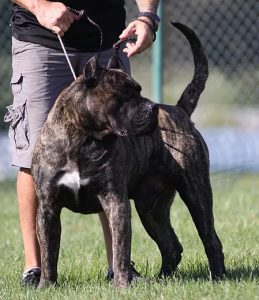Breed Health
One of the most common phrases you hear from “Presa” breeders is that this breed does not suffer from any of the congenital defects known to effect most other breeds. THIS IS FALSE! Too many dogs of this breed suffer from Displaysia. Why? Because very few test for it. Lots will say their dogs have healthy hips because of the way he moves, or can jump up in his pick-up truck. The Presa Canario has a very high tolerance for pain and therefore may have Displaysia and never show it. If the breeder does not screen for this disease, he has no clue, is not interested in breed improvement and is not someone you should purchase from. Another problem rampant in the breed, mostly in a majority of the American impure lines, is demodex mange. While all dogs, even people carry the mite that causes this problem, the appearance of this issue points to a diminished immune system and therefore a genetic problem. Another problem with the breed is entropian. This is an eye condition where the lid turns in and is very painful for the dog. It is mostly seen with a very short, typical head and can usually be handled by breeding for a longer muzzle. While this condition is treatable with surgery, it is genetic and a dog with this condition should not be bred unless the benefits of his other attributes add so much to a small gene pool as to warrant the risk. Progeny should be watched.

OFA or PennHIP?
OFA or PennHIP, which is better? We believe that a breeder who uses either of these tests is doing a tremendous service to the breed. Testing and evaluating the hips of our dogs is one of our first priorities. We have decided to use PennHIP as our primary source of hip evaluation. After hours of consultation with specialists of both testing methods, we’ve come to the conclusion that while OFA offers a subjective evaluation of the dogs hips, PennHIP offers a more comprehensive evaluation and a method that has been used to successfully remove the incidences of HD in entire lines of dogs. The same can not be said for OFA. OFA is an opinion of three board-certified vets, of one positioning of the dogs hips. PennHIP is measurements of three different x-rays of the dogs hips in positions more likely to show signs of looseness. OFA also does not always take into account that some breeds have an allowable amount of subluxation (looseness or laxity.) PennHIP evaluates your dogs hips against a number of factors, measurements and the average of your breed. PennHIP also recommends you lower your distraction index numbers as each generation goes and anyone who watches our program will noticed that is precisely what we do. We will be happy to show the PennHIP paperwork on any dog at any time. Please visit the PennHIP Website. A great article to read about the PennHIP method can be viewed by clicking the following link. PennHIP Benefits written by Fred Lanting.
A Small Gene Pool and Test Breeding.
The Presa has a very small gene pool. From its reclamation, about eight distinct lines emerged and are what we see in the US today. With that in mind, the importance of test breeding becomes abundantly clear. Dogs with type faults (not lacking in type) bred to dogs with excellent type……dogs lacking strong character (not cowards or maniacs) bred to dogs with excellent character……dogs with minor health issues bred to dogs of excellent health. All these pairings become necessary to improve and add to a small gene pool. This is where test breeding comes into play. While I will be the first to say no German Shepherd should be bred that is failing in one of the three big issues, type, temperament and health, with a small gene pool, it does sometimes become necessary to use a dog that has excellent qualities but may lack in one area. There are thousands of German Shepherds so finding one that excels in all three areas, should be easy.
Unfortunately with the state of dog breeding in general, this is not always the case either. At Cabeza Grande Kennel, we favor this test breeding as long as people are willing to keep track of the progress of the progeny and remove a problem dog from their breeding program. With breed improvement as a primary goal, this is how it should be. Contact us for more information!